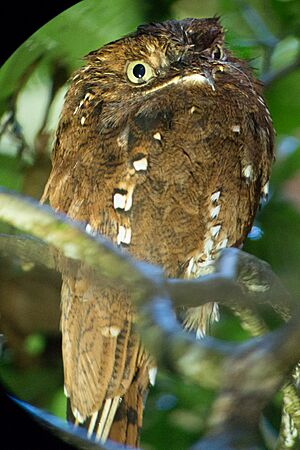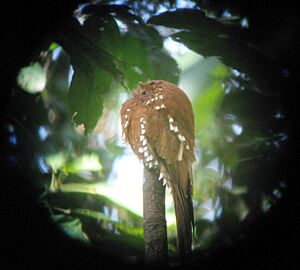Rufous potoo facts for kids
Quick facts for kids Rufous potoo |
|
|---|---|
 |
|
| Conservation status | |
| Scientific classification | |
| Genus: |
Phyllaemulor
|
| Species: |
bracteatus
|
 |
|
| Synonyms | |
|
Nyctibius bracteatus Gould, 1846 |
|
The rufous potoo (Phyllaemulor bracteatus) is a special kind of bird found in the forests of South America. It belongs to a family of birds called Nyctibiidae. This bird is unique because it's the only one in its group, called Phyllaemulor. You can find it in countries like Brazil, Colombia, Ecuador, French Guiana, Guyana, Peru, Suriname, and Venezuela.
Contents
How Scientists Study the Rufous Potoo
Scientists are always learning new things about animals. In 2009, some research showed that the rufous potoo is quite different from other potoo birds. It has different skull shapes and unique DNA. Because of these differences, scientists decided it should have its own special group, or genus, called Phyllaemulor.
This new group was officially named in 2018. Most big bird organizations, like the International Ornithological Committee, now agree with this change. The rufous potoo is also monotypic, which means it's the only species in its genus.
What Does the Rufous Potoo Look Like?
The rufous potoo is a small bird, about 21 to 25 cm (8.3 to 9.8 in) long. It weighs around 46 to 58 g (1.6 to 2.0 oz), which is about as much as a small apple. It is the smallest bird in its family.
This bird has a very unusual color. It is mostly a deep orange-red with big white spots. The color is lighter on its throat. The spots on its belly have a thin black edge, and its tail has darker stripes. It also has long, stiff hairs near its beak.
The rufous potoo looks a lot like a dead leaf. It even sits upright on a branch and sways gently, making it even harder to spot! This helps it hide from other animals.
Where the Rufous Potoo Lives
The rufous potoo lives in the Amazonia region of South America. You can find it from Venezuela down to Peru and east into Brazil, French Guiana, and Guyana. It might also live in Bolivia, but scientists are not completely sure yet.
This bird is only known from a few places, but it probably lives in more areas than we know. It mostly lives in forests where the soil isn't very rich, like sandy areas or near blackwater rivers. It prefers the lower and middle parts of both old and new terra firme forests. You might also find it in swampy palm forests. It usually lives in areas below 550 m (1,800 ft) in height.
Behavior
Feeding Habits
The rufous potoo is a skilled hunter. It finds a perch and then quickly flies out to catch flying insects. After catching its meal, it usually flies right back to the same spot. It eats many different kinds of insects.
Reproduction and Life Cycle
The rufous potoo's nesting season seems to be from September to possibly February. We don't know much about their nests because they are very rare to find. The "nest" is quite unusual: the bird simply lays its single egg on top of a broken tree stump.
Vocalization
The rufous potoo has a soft, fast song. It sounds like a series of 10 to 15 notes, like "bu-bu-bu-bu-bu..." or "whooo, tooo, tooo, tooo...". It sounds a bit like some small owls. This bird mostly sings around the time of the full moon. It also makes short "wup" or "urt" calls.
Status
The IUCN (International Union for Conservation of Nature) says the rufous potoo is a species of "Least Concern." This means it's not currently in great danger of disappearing. However, we don't know exactly how many of these birds there are, and their numbers might be going down. Scientists believe it will be safe as long as large parts of the Amazon rainforest stay healthy and untouched.



